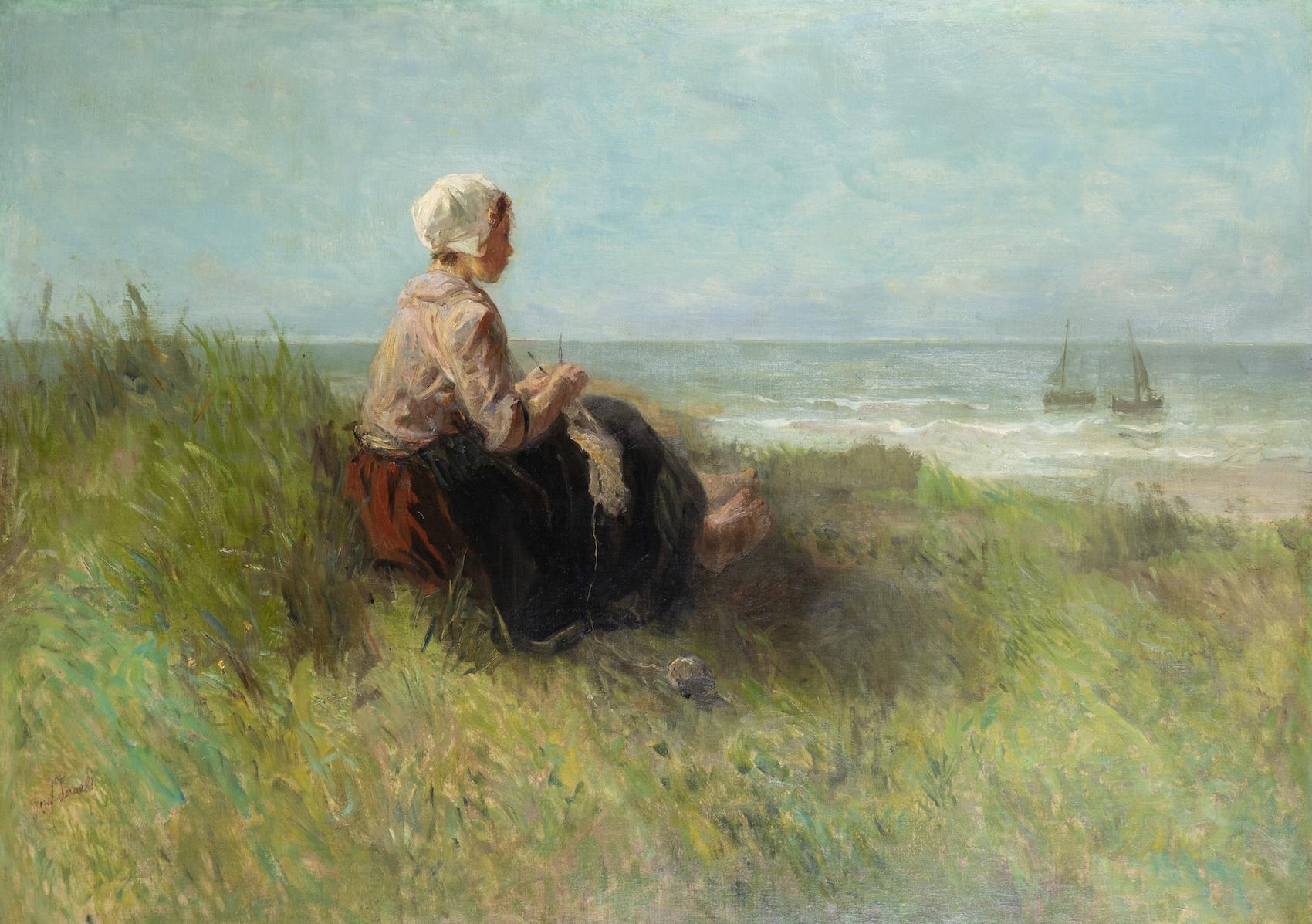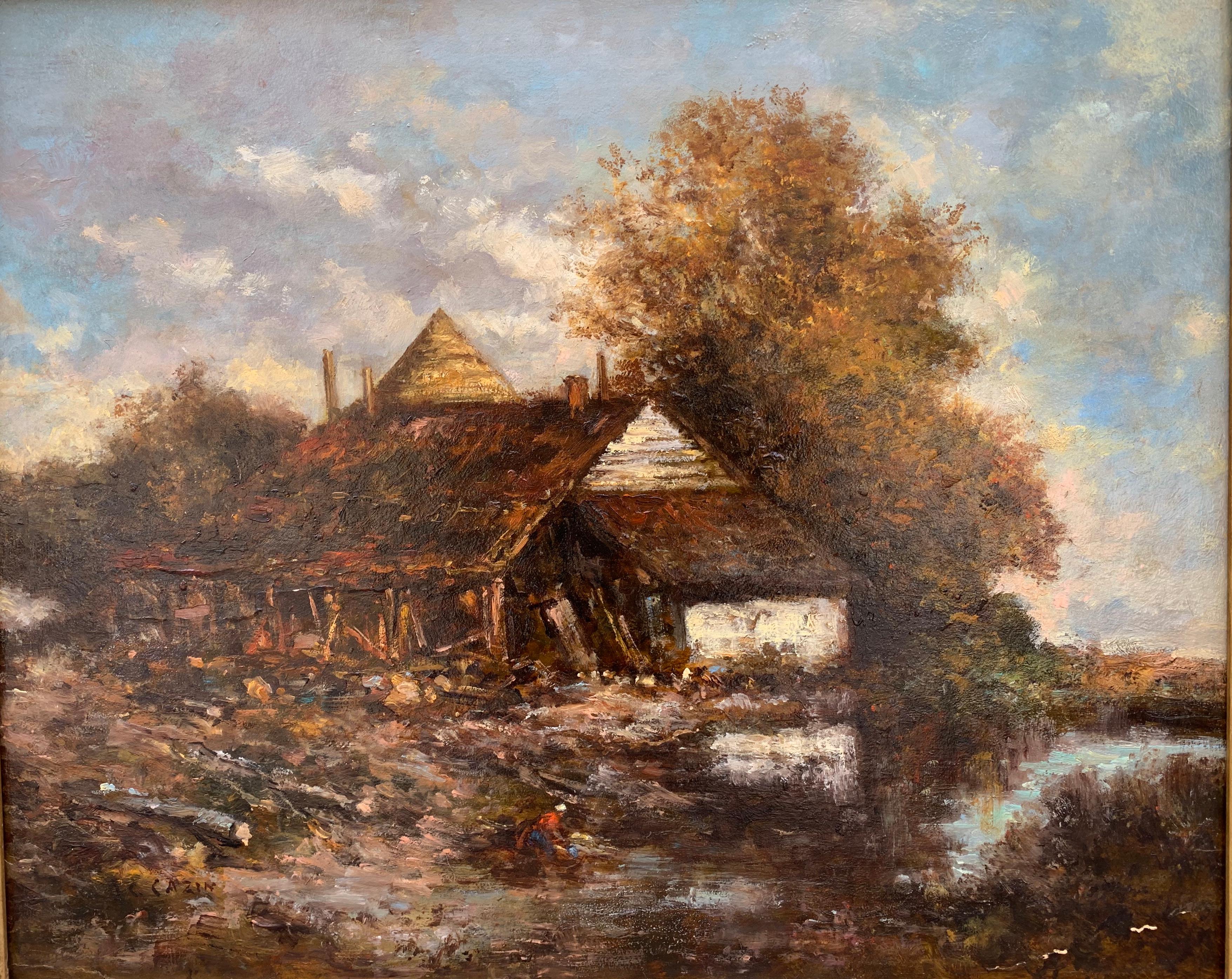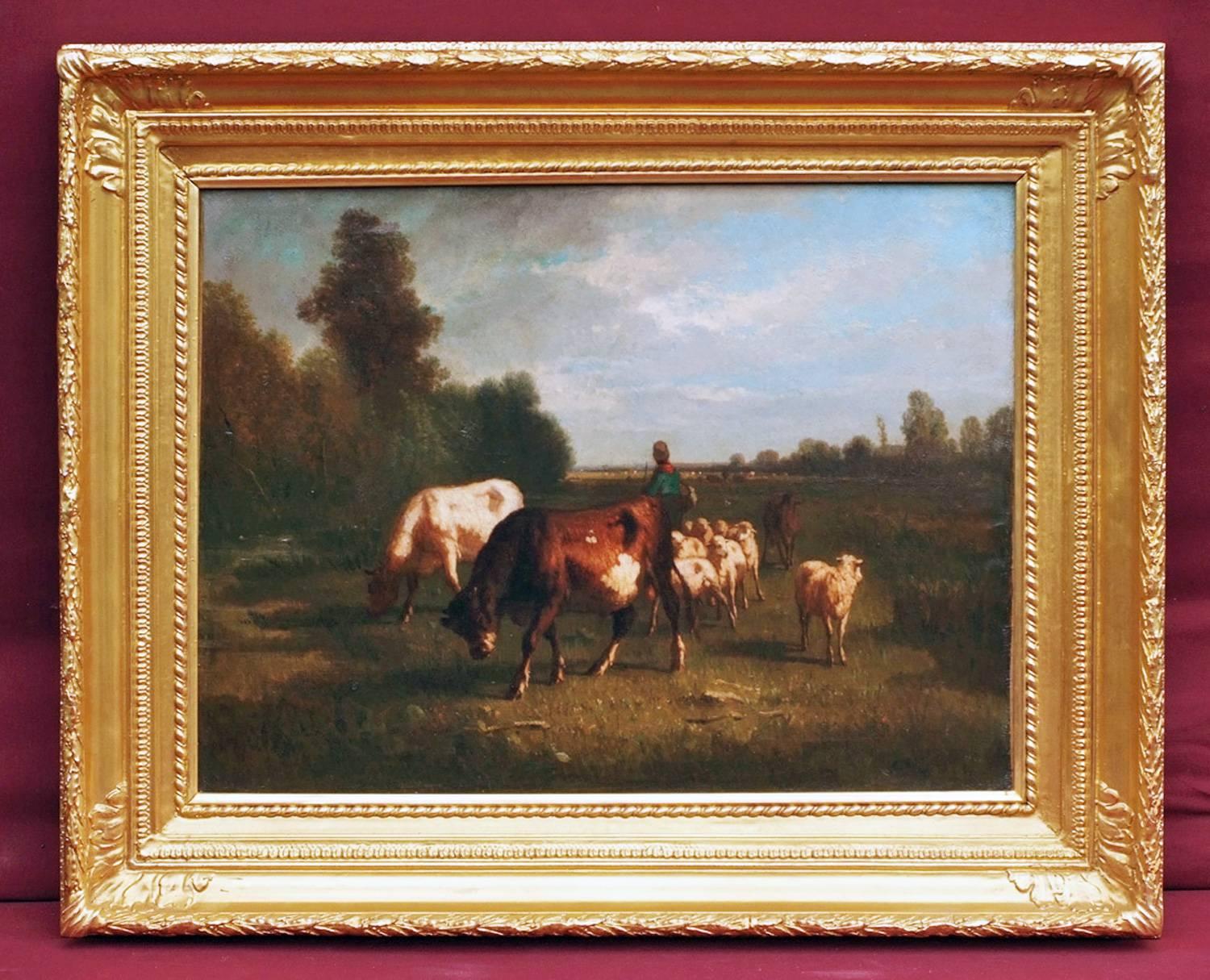Items Similar to A River Landscape
Want more images or videos?
Request additional images or videos from the seller
1 of 10
Karl DaubignyA River Landscape1867
1867
About the Item
Karl Pierre DAUBIGNY
With price reaching upwards of $36 000 this is opportunity to purchase a piece by an artist who was at the forefront of the impressionist movement at a price that has great potential investment. It has excellent provenance coming from the continent via Christies in the 1980s and is in many important museums from the
Musée d’Orsay, Paris to the Rijksmuseum, The Hague.
Oil on panel
Panel size: 11 x 21" (28 x 54cm)
Outside frame size: (48 x 74cm)
Born on 19 June 1846 in Paris and died on 25 May 1886
Painter of animals, landscapes, marines in both oil and watercolours
Karl Pierre Daubigny was the son of, Charles Francois Daubigny, one of the original eight Barbizon painters and one of the leading landscapists of his time. Taught by his father, who greatly influenced him, Karl Daubigny travelled the French countryside painting, working primarily in Auvers, Normandy and Fontainebleau.
He made his debut exhibition in 1863 with A Track (Un Sentier) and Île de Vaux in Auvers (L'Île de Vaux à Auvers), which showed his keen feel for nature in spring. He continued to exhibit regularly at the Salon. In 1866 he showed View Taken in Picardy (Vue prise en Picardie) and Halt of Bohemians (Halte de Bohémiens). He was awarded medals in 1868 and 1874.
While Karl Daubigny is often associated with a style much like that of his father he also was heavily influenced by Impressionism and Monet in particular. The influence of Impressionism is not surprising; the elder Daubigny was one of the greatest supporters of Monet and the Impressionists in the early years of the movement. During 1871 and 1872 Karl and his father made a painting trip with Monet to the canals of Zaandam. Karl’s approach at this time emulated the freedom, the use of impasto on his canvases and panels and the palette of Monet’s depictions of Zaandam.
Karl Daubigny died prematurely at the age of 40 on the 25th May 1886.
His prolific contribution to the second generation of Barbizon painters is evident in his ability to convey, through his painting, his devotion to and love of nature.
Karl Pierre Daubigny figured in the exhibition From Delacroix to Dufy: Cliffs and Rocks (De Delacroix à Dufy, Falaises et Rochers) at the Musée des Terre-Neuvas in Fécamp in 1998. In 2000 an exhibition featuring the works of both father and son for the first time was organised at the Musée Daubigny in Auvers-sur-Oise” (Benezit, Dictionary of Artists, Gründ, 2006).
Museum Collections:
Bristol Museum and Art Gallery, Bristol
Château-Musée de Dieppe, Dieppe
Culzean Castle, Maybole
Musée d’Orsay, Paris
Musée Daubigny, Auvers-sur-Oise
Museée de Grenoble, Grenoble
Musée des Beaux-Arts, Blois
Musée des Beaux-Arts, Brest
Musée de l’Ancien Evêché - Evreux
Musée des Beaux-Arts, Pau
Musée Thomas-Henry, Cherbourg-Octeville
Rijksmuseum, The Hague
Also, in the museums of Aix, Amiens, Bayonne, Berlin, Brest, Le Havre, Nancy, and Honfleur.
- Creator:Karl Daubigny (1846 - 1886, French)
- Creation Year:1867
- Dimensions:Height: 19 in (48.26 cm)Width: 29 in (73.66 cm)Depth: 3 in (7.62 cm)
- Medium:
- Movement & Style:
- Period:
- Condition:Original gold leaf frame. The frame is fragile but beautiful and we will do our utmost to protect it but can not guarantee the condition after shipping. An alternative frame could be provided which is stronger but will ultimately not be the original.
- Gallery Location:St. Albans, GB
- Reference Number:1stDibs: LU2469213744862
About the Seller
5.0
Gold Seller
These expertly vetted sellers are highly rated and consistently exceed customer expectations.
Established in 1965
1stDibs seller since 2023
19 sales on 1stDibs
Typical response time: 1 hour
- ShippingRetrieving quote...Ships From: St. Albans, United Kingdom
- Return PolicyA return for this item may be initiated within 7 days of delivery.
More From This SellerView All
- Sheep with their LambLocated in St. Albans, GBEdouard Woutermaertens A wonderful example of one of Belgium's most highly collected animal painters work. Painted on a beautiful panel it is signed and inscribed by the artist on t...Category
Mid-19th Century Barbizon School Animal Paintings
MaterialsOil
- A Shepherd with his Flock . Oil on canvasLocated in St. Albans, GBGaston Frederic De Burggraff Canvas Size: 15 x 21" (38 x 53cm) Outside Frame Size: 22 x 28" (56 x 71cm) A wonderful example of French Impressionism allied with the Barbizon style of...Category
Late 19th Century Barbizon School Landscape Paintings
MaterialsOil
- 'A Barbizon Landscape'. An antique oil paintingBy Edmond YonLocated in St. Albans, GBEdmond Charles Joseph YON Canvas Size: 12 x 21" (30 x 53cm) Outside Frame Size: 18 x 27" (46cm x 69cm) Antique oil painting 1836-1907 He was born and died in Paris and spent most ...Category
Late 19th Century Barbizon School Landscape Paintings
MaterialsOil
- Cattle Grazing in a Landscape. Oil on CanvasLocated in St. Albans, GBFrederick Vezin 1859 - 1933 Canvas Size: 13 x 18" (33 x 46cm) Framed Size 20 x 25" (51 x 64cm) 19th Century, oil on canvas Born Pennsylvania and died in Dusseldorf He was an American...Category
Early 20th Century Barbizon School Landscape Paintings
MaterialsOil
- The Ones that Got Away - Two Pointer Dogs by a RiverBy Eugène PetitLocated in St. Albans, GBEugene Petit 1839 - 1886 Oil on canvas Painting Size: 18 x 21 3/4" (46 x 56cm) Outside Frame Size: 25 x 28 3/4" (63 x 73cm) Free Shipping He was born in 1839 at Paris and died in...Category
Late 19th Century Barbizon School Animal Paintings
MaterialsOil
- Jamey - A Brindle Scottie TerrierBy Wright BarkerLocated in St. Albans, GBWright BARKER Exhibited 1885 - 1935 Canvas Size: 20 x 26" (50 x 65cm) Outside Frame Size: 29 x 35" (72.5 x 87.5) He was a figure and animal painter who was based originally in Brad...Category
Early 1900s Victorian Animal Paintings
MaterialsOil
You May Also Like
- Waiting by Jozef Israëls - Landscape oil paintingBy Jozef IsraëlsLocated in London, GBWaiting by Jozef Israëls (1824-1911) Oil on canvas 95.3 x 133.9 cm (37 ½ x 52 ¾ inches) Signed lower left, Jozef Israels A monumental painting by one of...Category
19th Century Barbizon School Figurative Paintings
MaterialsCanvas, Oil
- The Barn, Oil On Bord, Signed Jean-Charles Cazin, Barbizon School, 1865By Jean-Charles CazinLocated in Paris, FROil on panel representing a barn, signed JC Cazin on the lower left corner. Jean Charles Cazin (1840-1901) Born in Samer (his father, from Bologna,...Category
Late 19th Century Barbizon School Landscape Paintings
MaterialsOil
- Oil Painting 19th Century Cows Landscape BarbizonBy Antonio CortesLocated in Saint-Ouen, FRCORTES Antonio (1827-1908) Cows to pasture Oil on canvas signed lower left Old frame gilded with leaves Dim canvas : 54 X 65 cm Dim frame: 70 x 86 cm...Category
1860s Barbizon School Animal Paintings
MaterialsOil
- Barbizon School Lakeside Landscape With CastleLocated in Cotignac, FRAn oil on panel idyllic landscape by Boggio. The painting is signed bottom right. An idealised lakeside landscape view with a castle in the distance in the style of the Barbizon sch...Category
Mid-20th Century Barbizon School Landscape Paintings
MaterialsOil, Board
- Barbizon School Lakeside Landscape, The Shady Glen.Located in Cotignac, FRAn oil on panel idyllic landscape by Boggio. The painting is signed bottom right. An idealised lakeside landscape view of a shady glen in the style of the Barbizon school.Category
Mid-20th Century Barbizon School Landscape Paintings
MaterialsOil, Board
- The Forest, Large Barbizon School, Oil on Canvas Wooded LandscapeBy Emile Roux-FabreLocated in Cotignac, FRA French Barbizon School oil on canvas forest view by Emile Roux-Fabre. The painting is signed and dated bottom left with a dedication. A charming view of forest glade leading out to a valley landscape beyond. The artist has captured the magic feeling of the cool forest shade against the sunshine of the landscape beyond. The texture of the bark on the silver birch trees, the contrast of the leaves on the trees all framing the perspective to the view beyond. An extremely accomplished and atmospheric painting. The Barbizon school of painters was part of an art movement towards Realism in art, which arose in the context of the dominant Romantic Movement of the time. The Barbizon school was active roughly from 1830 through 1870. It takes its name from the village of Barbizon, France, on the edge of the Forest of Fontainebleau, where many of the artists gathered. Most of their works were landscape paintings, but several of them also painted landscapes with farmworkers, and genre scenes of village life. Some of the most prominent features of this school are its tonal qualities, colour, loose brushwork, and softness of form. The leaders of the Barbizon school were: Théodore Rousseau, Charles-François Daubigny, Jules Dupré, Constant Troyon, Charles Jacque, and Narcisse Virgilio Díaz. Jean-François Millet lived in Barbizon from 1849, but his interest in figures with a landscape backdrop sets him rather apart from the others. Jean-Baptiste-Camille Corot was the earliest on the scene, first painting in the forest in 1829, but his work has a poetic and literary quality which sets him somewhat apart. Other artists associated with the school, often pupils of the main group, include: Henri Harpignies, Albert Charpin, François-Louis Français and Émile van Marcke. In 1824 the Salon de Paris exhibited works of John Constable, an English painter. His rural scenes influenced some of the younger artists of the time, moving them to abandon formalism and to draw inspiration directly from nature. Natural scenes became the subjects of their paintings rather than mere backdrops to dramatic events. During the Revolutions of 1848 artists gathered at Barbizon to follow Constable's ideas, making nature the subject of their paintings. The French landscape became a major theme of the Barbizon painters. Millet extended the idea from landscape to figures — peasant figures, scenes of peasant life, and work in the fields. In The Gleaners (1857), for example, Millet portrays three peasant women working at the harvest. Gleaners are poor people who are permitted to gather the remains after the owners of the field complete the main harvest. The owners (portrayed as wealthy) and their laborers are seen in the back of the painting. Millet shifted the focus and the subject matter from the rich and prominent to those at the bottom of the social ladders. To emphasize their anonymity and marginalized position, he hid their faces. The women's bowed bodies represent their everyday hard work. In the spring of 1829, Jean-Baptiste-Camille Corot came to Barbizon to paint in the Forest of Fontainebleau, he had first painted in the forest at Chailly in 1822. He returned to Barbizon in the autumn of 1830 and in the summer of 1831, where he made drawings and oil studies, from which he made a painting intended for the Salon of 1830; "View of the Forest of Fontainebleau'" (now in the National Gallery in Washington) and, for the salon of 1831, another "View of the Forest of Fontainebleau"'. While there he met the members of the Barbizon school: Théodore Rousseau, Paul Huet, Constant Troyon, Jean-François Millet, and the young Charles-François Daubigny. During the late 1860s, the Barbizon painters attracted the attention of a younger generation of French artists studying in Paris. Several of those artists visited Fontainebleau Forest to paint the landscape, including Claude Monet, Pierre-Auguste Renoir, Alfred Sisley and Frédéric Bazille. In the 1870s those artists, among others, developed the art movement called Impressionism and practiced 'plein air' painting. In contrast, the main members of the school made drawings and sketches on the spot, but painted back in their studios. The Post-Impressionist painter Vincent Van Gogh studied and copied several of the Barbizon painters as well, including 21 copies of paintings by Millet. He copied Millet more than any other artist. He also did three paintings in Daubigny's Garden. The Barbizon painters also had a profound impact on landscape painting in the United States. This included the development of the American Barbizon school by William Morris Hunt. Several artists who were also in, or contemporary to, the Hudson River School studied Barbizon paintings for their loose brushwork and emotional impact. A notable example is George Inness, who sought to emulate the works of Rousseau. Paintings from the Barbizon school also influenced landscape painting in California. The artist Percy Gray...Category
Early 20th Century Barbizon School Landscape Paintings
MaterialsCanvas, Oil
Recently Viewed
View AllMore Ways To Browse
Normandy Landscape Painting
Painting Of A Chateau
Painting Of A French Castle
Monet Style Landscape
Charles River
French Landscape 1980s
De Orsay
Barbizon Painters
Barbizon Frame
Le Havre Painting
Barbizon Artists
Cliff May
Le Havre Paint
Barbizon School French Landscape Paintings
36x48 Landscape Oil Painting
Track 21
Chateau Panel
48x36 Used Frames





